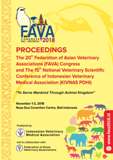PF-18 Photomicrograph of Nanogel Andrographolide-Beta Cyclodextrine Inclusion Complex As Anti-Burns
Abstract
Inclusion complex is a complex formed between drug molecules which act as guest or located inside the cavity of host molecule. Host molecules are commonly originated from the derivative group of cyclodextrin. Among cyclodextrin groups, beta cyclodextrin (BCD) is mostly used in formula development and drug delivery system [1].
Andrographolide (AG) is a pure isolate chemically syntesized from sambiloto herbs (Andrographis paniculata Nees), in the form of needle cystal-like which is colorless and extremely bitter. AG has variety of medical properties, particularly as anti-inflamation to treat skin burns [2]. However AG has poor solubility in water. This will result in low abillity to solute, penetrate membrane, and distribute the drug when applied transdermally in burn skin. In burn skin, there is tendency to skin damage, especially in stratum corneum which acts as semipermeable barrier. The ability of drugs that applied transdermally tends to be high.
Formation of inclusion complex using AG and BCD to increase the ability of AG in penetrating membrane should be done. Transmission Electron Microscope (TEM) is a fast technique to confirm the formation of drug or inclusion complex by comparing the shape and particle size [3]. Study on percutaneous penetration of AG-BCD inclusion complex is produced through solvent evaporation method at mole ration 1:2 in viscolam gel preparation.

